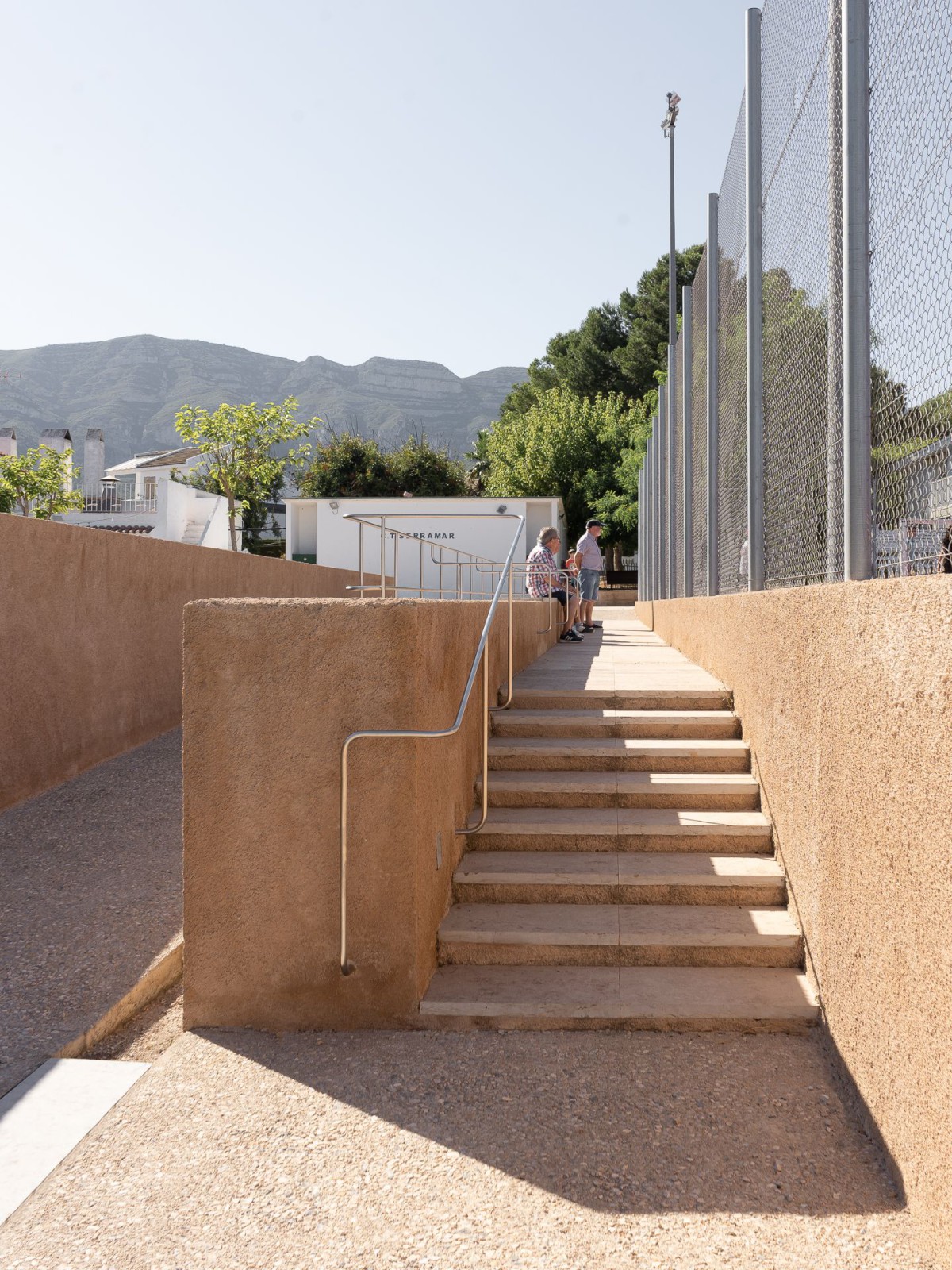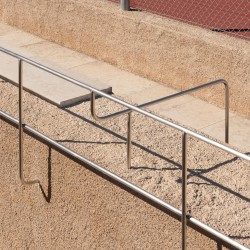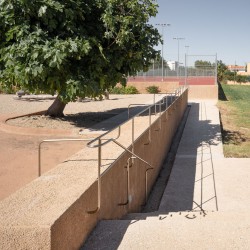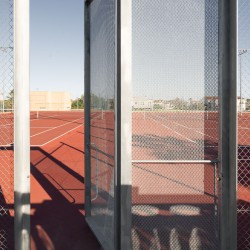Bajet Giramé . JAAS . photos: © Joan Guillamat
Located by the “Alfaques” Bay, the exterior spaces of an historical rural construction (called Masía) had been reduced to residual interstices in-between autonomous pieces for touristic use: a few tennis courts, the terrace of a restaurant, a pool and a solarium. These were the result of modest works of renovation accumulated overtime following the sporadic needs of a modestly run management.
Landscapes in the meantime
This project was born “uncommisioned” since the client was simply considering the upgrade of the tennis courts, until the focused was turned into the improvement of such interstices and walkways in order to provide an infrastructural support for the uncertain future developments.
Taking the agricultural terraces in the surrounding territory as a model, the project consolidated two large surfaces and, particularly, involved the definition of its borders and the interstices amongst them: permanent walkways, small corners, and a gently sloped ramp. For their construction, Senia Stone—sourced from a nearby quarry—was used in all of its possible forms. The interstices between platforms were turned into an infrastructure channeling people, energy and water, to be stored in a subterranean reservoir used to water all the exteriors spaces and gardens with autochthonous species.
De-urbanize, drain and cycle the water
We suggested doing away with one of the tennis courts to increase the surface drainage in front the masía. Then, we used the large surfaces of the courts and the paths surrounding them to improve the flow of water. As a result, water conduits were built to capture runoff during the seasonal bouts of rain, and to feed this water into an underground reservoir, used to irrigate the property’s green areas. These, in turn, are largely populated by autochthonous species, which require very little water and are salt-tolerant. They include shrubs, such as cotton lavender, lavender, and the so-called Spanish broom, as well as trees, like the white mulberry.
Terraces: the permanent settings for changing activities
The new platforms function as the permanent settings for a series of changing activities, solving the “meantime” situations. For its construction, and following local customs, no soil was extracted during the construction of these platforms. Instead, the terrain was shaped into terraces and, to minimize the amount of residue generated, the remains of the former courts were used to stabilize the new ones.
Cuts, scraps and gravel from Sénia
Above all, the constructive phase of the project involved delineating the borders and the intervening space between the infrastructural platforms, and in this sense, a pragmatic decision was made: all construction solutions start from the use of Sénia stone – sourced from a quarry only 10 km away – that was used in all of its possible forms, thus avoiding the unnecessary generation of rubble. To define important meeting spots, the project uses cut stone of standardized dimensions as ‘carpets’ of sorts. Then, the fragments generated in the cutting of stone were repurposed to extend an already existing ‘pavement of fragments,’ and were embedded in the floor following a pattern of structured randomness. Gravel, in turn, was used as a drainage surface and as an exposed aggregate of the water blasted concrete. Finally, in its smallest format – as sand – the stone was used for the traditional renderings of the walls.
_
Tenis Serramar, 2020
Alcanar (Tarragona-Spain)
Bajet Giramé + JAAS
(Pau Bajet, Maria Giramé, Manuel Julià)
2.800 sqm
Fotos de Joan Guillamat
Paisajes del mientrastanto Frente la bahía dels Alfacs, los espacios exteriores de una histórica masía, habían quedado reducidos a intersticios residuales entre piezas autónomas para la explotación turística: unas pistas de tenis, la terraza de un restaurante, una piscina y un solárium. Ello era el resultado de pequeñas obras de mejora sucedidas de manera accidental a lo largo de cincuenta años, ante necesidades esporádicas de una humilde operativa turística. Este proyecto, que consiste en la mejora de dichos intersticios nace “sin encargo” del cliente—quien simplemente iba a realizar otra mejora más: las pistas de tenis—y con el objetivo de ofrecer un soporte infraestructural que encauce la incertidumbre de las transformaciones venideras. De manera análoga a las terrazas agrarias del territorio circundante, el proyecto consolida grandes plataformas y aborda la definición de sus bordes y el intersticio entre ellas: pequeños rincones de encuentro, pavimentos y topografías. Todos ellos se construyen mediante un mismo material, la piedra de Senia, de una cantera cercana, que se incorpora en todos sus posibles formatos. El intersticio entre plataformas se convierte en una infraestructura por donde fluyen personas, energía y agua, hasta su acumulación en un aljibe subterráneo que permite el riego de los exteriores ajardinados con comunidades vegetales autóctonas Des-urbanizar, drenar y ciclo del agua Sugerimos reducir una pista de tenis para poder incrementar la superficie exterior drenante y ajardinada delante de la masía. A parte de reducir la cobertura de suelo impermeable, la propuesta aprovecha la gran superfície de las pistas deportivas, así como sus recorridos perimetrales para el aprovechamiento del ciclo del agua. Por este motivo, se integran unas “acequias” colectoras que permiten visibilizar la escorrentía del agua en los episodios de lluvia estacional hasta su acumulación en un aljibe subterráneo que permite el riego de los espacios ajardinados. Estas, incorporan comunidades vegetales autóctonas, de muy baja demanda hídrica y una alta resistencia a la salinidad marina, como la santolina, la lavanda y la ginesta utilizado en las especies arbustivas y la morera en las arbóreas. Aterrazamientos: soportes de actividad transformables Las nuevas plataformas se entienden como apoyos permanentes de actividades cambiantes, resolviendo el momento presente del “mientrastanto”. Para su construcción, siguiendo la tradición vernacular, no se han extraído tierras, sino que se ha aterrazado el terreno y, a su vez, con el fin de reducir los residuos generados durante las obras, los derribos de las pistas anteriores se utilizan para la estabilización de las sub-bases de las nuevas pistas. Cortes, retazos y gravas, de Sénia El proyecto constructivo aborda, sobretodo, la definición de los bordes y recorridos entre las plataformas infraestructurales y, en este sentido, se toma una decisión pragmática: todas las soluciones constructivas parten del uso de la piedra de Sénia, sacada de una cantera a escasos 10 km, y se incorpora en todos sus posibles formatos desde su extracción, evitando la generación de material de escombro. Así pues, la propuesta utiliza piedra cortada de dimensiones estandarizadas para identificar pequeñas alfombras como puntos de encuentro; piedra rota de desperdicio del corte para dar continuidad a un pavimento “de fragmentos” existente, con una colocación embebida, entre aleatoria y reglada; la piedra en formato de grava en granulometrías varias como pavimento drenante, como agregado visto del hormigón desactivado y, en su formato más pequeño, como árido para los revocos tradicionales de los muros.

















